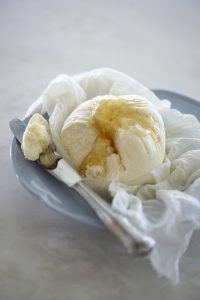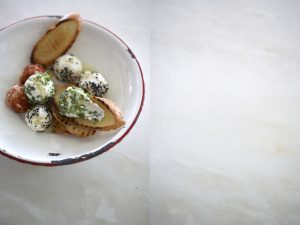

Fermented, cultured and strained dairy products are some of the oldest and most original ways of preserving food. Before refrigeration and preservatives were invented to prolong shelf-life, the natural effect of bacterial and enzymatic action was skilfully applied by domestic cooks in order to stock the larder. Since milk changes rapidly when exposed to warmth, simple home-made cheeses and drinks like kefir or yoghurt quickly evolved in all cultures where herds of cattle or flocks of goats and sheep are kept, whether nomadic or pastoral.
Like most dishes of peasant origin, dairy tastes infinitely better made at home than when commercially bought. It may sound a bit nerve-wracking for a novice to venture into the seemingly treacherous waters of home-made dairy foods, but you’ll soon enough find that your instincts and common sense serve you nicely, as it did the rural babuschkas or grandmères of 300 years ago.
A word of caution: make sure all your utensils and draining cloths are spanking clean, and be wary of making dairy on the hottest summer days as it might spoil rapidly. And everyone knows what ‘off’ smells like, so if your yoghurts or cheeses smell distinctly off rather than cheesy or yeasty, chuck ’em. You’d rather live to see another day and try again, wouldn’t you?
Home-made yoghurt
Plain, live culture yoghurt is indispensible in my kitchen. I add it to stews or curries, spoon dollops onto my favourite warm bean or lentil salads and use it in marinades to tenderise meat or chicken. One of my favourite drinks is lassi – an Indian beverage made from thinning plain yoghurt with some iced water before blending with either sweet or savoury flavourings, like mango, banana or toasted cumin and fresh mint. It’s also a great tonic for sun-frazzled skin! And of course it makes a brilliant breakfast with some organic honey drizzled on top and a pinch of cinnamon, with or without granola.
Have a go at this easy recipe. The trick is to keep the culturing yoghurt at a constant temperature of 38 degrees Celsius, which is why a yoghurt maker or thermos flask works so well.
Makes 3 cups (750ml)
Ingredients:
600ml fresh or long-life full-cream milk
150ml fresh live natural yoghurt
Method:
- Bring the milk to the boil in a large stainless steel saucepan so that it bubbles to the brim of the pot and let it bubble like that for 2 minutes.
- Remove from the heat immediately and let cool to blood heat – about 38 degrees Celsius. You should be able to keep your finger in the milk without burning for 10 seconds.
- Now gently stir in the natural yoghurt until thoroughly blended.
- Prewarm a Thermos flask by filling it with boiling water and quickly emptying again. Pour the yoghurt into the flask and quickly screw on the lid. (This may be easier if you pour the yoghurt into a jug first).
- Leave undisturbed in a draught-free, warm place for 7-10 hours to set, after which it can be transferred to an airtight container and kept in the fridge for up to one week. The cold stops the further development of the bacteria that makes the yoghurt set.
COOK’S TIP: Home-made yoghurt is thinner and not as smooth as the commercial variety. If you’d prefer a thicker, creamier texture, add 1-3 T (15-45ml) skim milk powder to the milk when you boil it. If your yoghurt tastes overly acidic, it means the temperature at which it incubated was too high, and if it tastes too sweet, the temperature while culturing was too low. I find using a wide-mouthed, pre-warmed Thermos flask circumvents this problem, but some cooks prefer a commercial yoghurt maker. And remember to keep ¼ cup (60ml) aside to start your next batch of home-made yoghurt!
Yoghurt cheese – labneh
So now you’ve made your yoghurt, learn to make some yoghurt cheese balls! These Middle-Eastern delights are commonly made from goat or ewe’s milk, and sold packed in oil in jars. Serve them freshly made, rolled in chopped herbs, black pepper or sesame and poppy seeds, or pack them into a sterilized jar, cover with good olive oil and keep in the refrigerator for up to 1 month. A lovely appetiser with pita breads, olives and other meze.
Of course you can use bought live yoghurt to make your labneh as well. Labneh doesn’t have to be rolled into balls; it is also frequently served simply spooned into a dish to be scooped up with chunks of bread.
Makes about 48 balls.
Ingredients:
1kg live natural yoghurt – (goat or ewe’s milk if you can find it, or thick Greek-style yoghurt)
1 T (15ml) sea salt
1 T (15ml) ground black pepper
600ml olive oil
1 T (15ml) fresh rosemary – leaves stripped from the stems
5 sprigs fresh thyme
4 fresh bay leaves
2 small dried chillies
3 garlic cloves, lightly crushed
Method:
- Line a colander with a clean J-cloth that you have quickly rinsed in water. Place the colander over a bowl large enough to catch any drips.
- Mix the yoghurt very well with the salt and pepper and spoon into the colander.
- Cover and leave overnight in the fridge – between 16-24 hours will do.
- Make the labneh balls by rolling teaspoonfuls between your palms. Put the balls on a clean baking tray lined with clingfilm, cover lightly with more clingfilm and leave in the fridge once more for 8-12 hours. This will firm the balls up and dry out any excess moisture.
- Now you can serve your labneh, perhaps first rolling in some finely chopped herbs, black pepper, paprika, seeds or chopped nuts. Otherwise layer them in a sterilized glass jar with the seasonings given above, cover with olive oil, seal and keep in the fridge for up to one month.
COOK’S NOTE: If you regularly make your own dairy products, keep a supply of new kitchen wipes (J-cloths) handy for draining yoghurts, cheeses and so on.
Fromage blanc (fromage frais)
Fromage blanc is a low-fat, soft, smooth white cheese beloved in France, where it is often used in stuffings or paired with fruits for simple desserts. Combined with crème fraiche and drained in muslin overnight to firm up it also makes a gorgeous cream cheese that goes very well with olives, nuts, herbs or in salads. All recipes are given below.
Makes about 2 cup (500ml)
Ingredients:
1 cup (250ml) labneh or smooth low fat cottage cheese
1 cup (250ml) live natural yoghurt
1 T (15ml) fresh lemon juice
Method:
- Beat the ingredients together very well until smooth. Keep in an airtight container in the fridge for up to a week.
Crème fraiche
Crème fraiche is lightly soured, thick and creamy and melts into a luscious silkiness when used in cooking or baking. More easily obtainable these days than before, it nonetheless remains a breeze to make your own at home.
Makes 2 cups (500ml)
Ingredients:
2 cups thick cream
2 T (30ml) fresh buttermilk
Method:
- Stir the buttermilk very thoroughly through the cream. Cover the bowl tightly with cling film and leave undisturbed in a warm place for up to 12 hours to thicken.
- Keep in an airtight container in the fridge for up to 2 weeks – it will continue to thicken and develop flavour.
Fresh cream cheese
This soft white cheese is delicious in salads, sprinkled with olive oil and herbs. Or try it with some very good prosciutto and marinated artichokes. Use much like you would mozzarella.
Makes about 300g
Ingredients:
300g fromage blanc
100ml crème fraiche
Method:
- Line a colander with muslin or a new J-cloth that you have briefly rinsed in water. Place the colander over a bowl large enough to catch any drips.
- Blend the fromage blanc and crème fraiche together very well and spoon into the colander. Cover and leave overnight in the fridge to drain excess moisture.
- Place the cheese between two plates or boards for 2 hours to drain off further moisture and firm up. Wrap in cling film or put in an airtight container and keep in the fridge for up to 4 days.
Garlic and herb soft white cheese
You might know the commercial version of this, sold as Boursin. Use either labneh, fromage blanc or fresh cream cheese for this luscious, garlicky spread. Fresh herbs work best, about one cup in all (250ml) of whatever you like. My favourite herb mix for this is half chives, half parsley and a mere teaspoon (5ml) dried tarragon.
Makes about 2 cups (500ml)
Ingredients:
2 t (10ml) crushed fresh garlic
2 cups (500ml) fresh soft white cheese
1 cup (250ml) of your favourite fresh green herbs or a mixture
1 t (5ml) sea salt
½ t (2.5ml) black pepper
Method:
- Use a wooden spoon to mash everything together, or do it in your blender, until smooth and thoroughly blended.
- Transfer to an airtight container and keep in the fridge for up to 1 week.
COOK’S TIP: stir in 1 T (15ml) cream for a richer taste.
